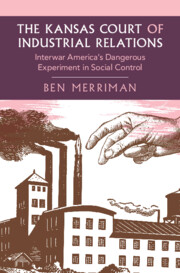Refine search
Actions for selected content:
44 results
1 - The Court That Failed
-
- Book:
- The Kansas Court of Industrial Relations
- Published online:
- 26 July 2025
- Print publication:
- 14 August 2025, pp 1-32
-
- Chapter
-
- You have access
- HTML
- Export citation
2 - Progressivism without Experts
- from Part I - The KCIR in Kansas
-
- Book:
- The Kansas Court of Industrial Relations
- Published online:
- 26 July 2025
- Print publication:
- 14 August 2025, pp 35-65
-
- Chapter
- Export citation
Afterword
- from Part II - The KCIR in the World
-
- Book:
- The Kansas Court of Industrial Relations
- Published online:
- 26 July 2025
- Print publication:
- 14 August 2025, pp 218-236
-
- Chapter
- Export citation

The Kansas Court of Industrial Relations
- Interwar America's Dangerous Experiment in Social Control
-
- Published online:
- 26 July 2025
- Print publication:
- 14 August 2025
Occupational Liberty and Licensing before the US Civil War
-
- Journal:
- Journal of Policy History / Volume 37 / Issue 2 / April 2025
- Published online by Cambridge University Press:
- 10 March 2025, pp. 114-137
-
- Article
- Export citation
4 - Post-miracle
-
- Book:
- Why the Ancient Greeks Matter
- Published online:
- 06 February 2025
- Print publication:
- 06 February 2025, pp 151-170
-
- Chapter
- Export citation
Conclusion
-
- Book:
- Schopenhauer's Politics
- Published online:
- 09 January 2025
- Print publication:
- 23 January 2025, pp 244-255
-
- Chapter
-
- You have access
- Open access
- HTML
- Export citation

Evolutionary Aestheticism in Victorian Culture
-
- Published online:
- 05 December 2024
- Print publication:
- 12 December 2024
“Granting” Justice, Debating Delinquency: The Juvenile Delinquency and Youth Offenses Control Act and the UNC Training Center on Delinquency and Youth Crime, 1961–1967
-
- Journal:
- Journal of Policy History / Volume 36 / Issue 3 / July 2024
- Published online by Cambridge University Press:
- 27 August 2024, pp. 308-323
-
- Article
- Export citation
4 - Ida Tarbell’s America
-
- Book:
- How Government Built America
- Published online:
- 08 May 2024
- Print publication:
- 09 May 2024, pp 33-50
-
- Chapter
- Export citation
22 - The Essay and the American Left
- from Part III - Postwar Essays and Essayism (1945–2000)
-
-
- Book:
- The Cambridge History of the American Essay
- Published online:
- 28 March 2024
- Print publication:
- 14 December 2023, pp 378-394
-
- Chapter
- Export citation
21 - “Everything Is on Edge”: World War I and the American State
- from Part V - Social and Economic Legislation
-
- Book:
- The Taft Court
- Published online:
- 19 October 2023
- Print publication:
- 09 November 2023, pp 689-719
-
- Chapter
- Export citation
28 - Prohibition, the Taft Court, and the Authority of Law
- from Part VI - The Positive Law of Prohibition
-
- Book:
- The Taft Court
- Published online:
- 19 October 2023
- Print publication:
- 09 November 2023, pp 921-947
-
- Chapter
- Export citation
Introduction
-
- Book:
- Grand Strategies of the Left
- Published online:
- 19 October 2023
- Print publication:
- 02 November 2023, pp 1-11
-
- Chapter
- Export citation
4 - Principles of Progressive Worldmaking
-
- Book:
- Grand Strategies of the Left
- Published online:
- 19 October 2023
- Print publication:
- 02 November 2023, pp 60-81
-
- Chapter
- Export citation
7 - Peacemaking as a Progressive Grand Strategy
-
- Book:
- Grand Strategies of the Left
- Published online:
- 19 October 2023
- Print publication:
- 02 November 2023, pp 128-152
-
- Chapter
- Export citation
5 - Progressive Pragmatism as a Progressive Grand Strategy
-
- Book:
- Grand Strategies of the Left
- Published online:
- 19 October 2023
- Print publication:
- 02 November 2023, pp 82-106
-
- Chapter
- Export citation
2 - Liberal Internationalism and Its Critics
-
- Book:
- Grand Strategies of the Left
- Published online:
- 19 October 2023
- Print publication:
- 02 November 2023, pp 23-37
-
- Chapter
- Export citation
8 - Varieties of Progressive Political Economy
-
- Book:
- Grand Strategies of the Left
- Published online:
- 19 October 2023
- Print publication:
- 02 November 2023, pp 153-177
-
- Chapter
- Export citation
9 - Political Terrain and Social Democratic Statecraft
-
- Book:
- Grand Strategies of the Left
- Published online:
- 19 October 2023
- Print publication:
- 02 November 2023, pp 178-210
-
- Chapter
- Export citation
